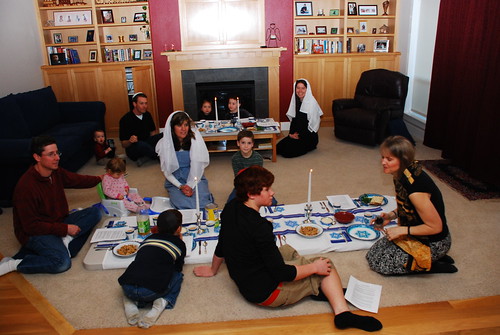BACKGROUND
Spring Feasts - Passover, Unleavened Bread, and Firstfruits of Barley and Wheat
Leviticus 23 - The Feasts of Israel
Here is a "Feasts Chart" that will give you a great overview of this chapter as well as the scarlet thread significance of each of the feasts. Feel free to print it out.
The feasts allowed the people of Israel to have "appointed" times throughout the year to look back upon God's faithfulness in their history and forward to the time of the Messiah. There were seven. The first in the cycle was Passover. Here is a link to the dates for the feasts that vary from year to year: Jewish Feasts.

 Passover and Unleavened Bread are often just lumped together and called "Passover/Pesach" because they occur together over an eight day period.
Passover and Unleavened Bread are often just lumped together and called "Passover/Pesach" because they occur together over an eight day period.
The Passover looks back at the redemption of the firstborn when God "passed over" the Israelite homes sparing the firstborns of the household during the last plague. It looks forward to Christ's redeeming death. The wine of Passover signifies Christ's blood.
The Feast of Unleavened Bread was to begin the morning after the Passover lamb was sacrificed. It commemorated the flight from Egypt. You might remember that God told them not to leaven their bread (Exodus 12:14-20). It looks at leaven as a symbol of sin. The Jews do not eat anything with leaven in it for seven days. They clear their houses of it. It represents Jesus as the sinless Bread of Life. This combined with Passover is the feast where all males were required to be in Jerusalem.
The Feast of First Fruits is celebrated on the day after the Sabbath following Passover. It was the first fruits of the barley harvest that occurs in March-April. It represents Jesus' resurrection. He was the "first fruits" of the dead (1 Cor. 15:20). This started seven weeks of gladness that ended at the wheat harvest of Shavuot
Feast of Weeks - Wheat Harvest (Pentecost or Shavuot)
Sometimes called the Feast of Harvest or Feast of the First Fruits, it falls 50 days after Passover and originally celebrated the end of the seven-week grain-harvesting season. In later tradition, it also celebrated the giving of the Law to Moses on Mount Sinai. This was a feast that required that all males attend the central place of worship in Jerusalem. It was the day when God-fearing Jews from many peoples saw the "first fruits" of the Holy Spirit in Acts 2:1-13.
Fall Feasts - Trumpets, Day of Atonement, and Booths
Feast of Trumpets (Rosh Hashanah)
This day marks the beginning of the Jewish year and opens the Ten Days of Penitence called "High Holy Days" or "Days of Awe" which close with Yom Kippur. One tradition is called tashlich which is the Hebrew word for "thou shalt cast into the seas." Jews traditionally go to a river or body of water and cast rocks which designate sins for which they are sorry. We did this when the kids were small, and it was quite fun!
Day of Atonement (Yom Kippur)
This day marks the end of the Ten Days of Penitence that began with Rosh Hashanah. It is a day of rest and was discussed in Leviticus 16. It is for repentance and fasting.
Feast of Tabernacles/Booths (Sukkoth)
This feast looks back at the wandering of the Israelites in the wilderness. Sukkoth was the first stopping place for the Israelites. Sukkoth means "huts" in Hebrew. Jacob journeyed there, and he built himself a house and made booths for his livestock (Genesis 33:17). It is a seven day feast where Jews live in huts. It is my favorite! This is another feast that required all males to attend the central place of worship in Jerusalem. This feast also includes a water festival in which Jesus proclaimed He was the Living Water (John 7:37-38).
NOTE: All feasts begin at sundown on the previous day
Leviticus 24 - This chapter covers regulations for the sanctuary.
Leviticus 24 - This chapter covers regulations for the sanctuary.
REFLECTION
In 1992 -1993, we got together with 25 other people and celebrated the feasts together. It was a blast! I heartily recommend it. They contain so much rich symbolism and spiritual truth. I was amazed at how much it helped me in my study of John a few years later since many of the important things that Jesus did during his public ministry occurred during these feasts!
APPLICATION
Celebrating Biblical Feasts by Martha Zimmerman is an excellent tool for understanding the feasts, and their significance to us as New Testament believers. We used it when we did it with our group.
by Martha Zimmerman is an excellent tool for understanding the feasts, and their significance to us as New Testament believers. We used it when we did it with our group.
You might want to consider celebrating some of these feasts with family and friends. The pictures above were from a Passover that we did before Easter in 2008 with some Bible Book Club families!
PRAYER
Lord, we worship You and adore You as our living God. Thank You that You created these feasts to remind us of Your faithfulness in the past and the fulfillment of Your promises in the future. Amen.

1 comment:
We celebrated Passover (Phil is in the picture above) with the Wroblickys and others again this year (2023). I think we have done it with them about five times!
Post a Comment